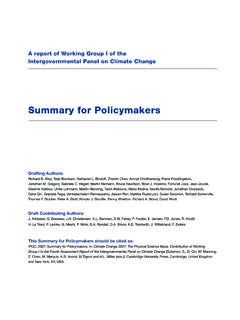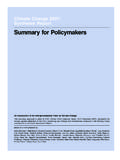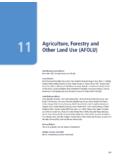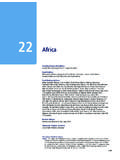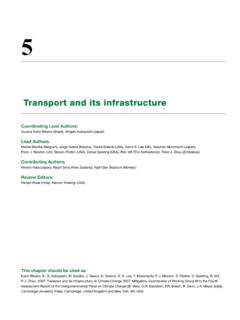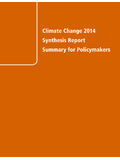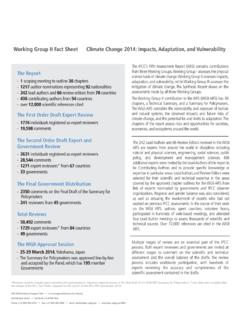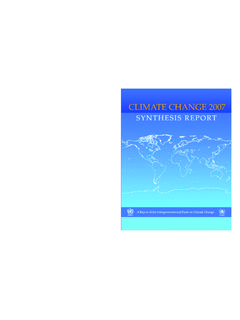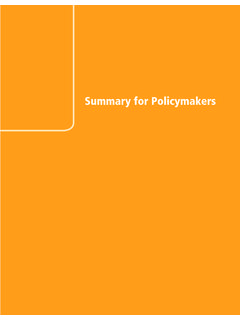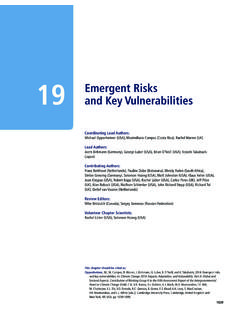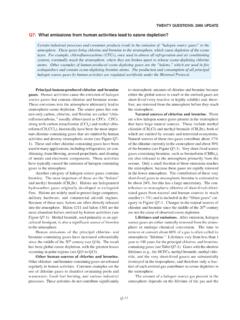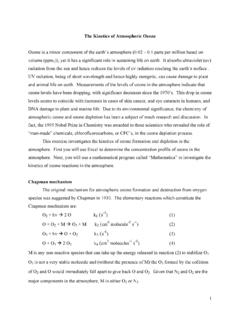Transcription of Atmospheric Chemistry and Greenhouse Gases
1 Atmospheric Chemistry and Greenhouse GasesCo-ordinating Lead AuthorsD. Ehhalt, M. Prather Lead AuthorsF. Dentener, R. Derwent, E. Dlugokencky, E. Holland, I. Isaksen, J. Katima, V. Kirchhoff, P. Matson,P. Midgley, M. WangContributing AuthorsT. Berntsen, I. Bey, G. Brasseur, L. Buja, Collins, J. Daniel, DeMore, N. Derek, R. Dickerson,D. Etheridge, J. Feichter, P. Fraser, R. Friedl, J. Fuglestvedt, M. Gauss, L. Grenfell, A. Gr bler, N. Harris,D. Hauglustaine, L. Horowitz, C. Jackman, D. Jacob, L. Jaegl , A. Jain, M. Kanakidou, S. Karlsdottir,M. Ko, M. Kurylo, M. Lawrence, Logan, M. Manning, D. Mauzerall, J. McConnell, L. Mickley,S. Montzka, M ller, J. Olivier, K. Pickering, G. Pitari, Roelofs, H. Rogers, B. Rognerud, S. Smith,S. Solomon, J. Staehelin, P. Steele, D.
2 Stevenson, J. Sundet, A. Thompson, M. van Weele,R. von Kuhlmann, Y. Wang, D. Weisenstein, T. Wigley, O. Wild, D. Wuebbles, R. YantoscaReview EditorsF. Joos, M. McFarland4 ContentsExecutive Sources of Greenhouse Atmospheric Chemistry and Trace Gas Budgets and Atmospheric Lifetimes and Gases : Current Observations, Trends Non-CO2 Kyoto Methane (CH4) Nitrous oxide (N2O) Hydrofluorocarbons (HFCs) Perfluorocarbons (PFCs) and sulphur hexafluoride (SF6) Montreal Protocol Gases and Stratospheric ozone (O3) Reactive Carbon monoxide (CO) and hydrogen (H2) Volatile organic compounds (VOC) Nitrogen oxides (NOx) Tropospheric Stratospheric Tropospheric OH and Photochemical Laboratory data and the OH lifetime of Greenhouse Atmospheric measurements and modelling of of Future The Adjusted/Augmented IPCC/SRES Emission Shifting Regional Emissions of NOx, CO and VOC in Projections of Natural Emissions in 2100 of Atmospheric Composition for the 21st Century The OxComp Testing CTM Simulation of the Current (Y2000)
3 Model Simulations of Perturbed and Y2100 Atmospheric Composition for the IPCC Scenarios to Gaps in These Projections - the Need for Coupled Sensitivity Analysis for Individual Sectors Chemical Processes Important on the Global Missing Chemistry , representation of small scales, and changing emission Aerosol interactions with tropospheric O3and Stratosphere-troposphere coupling Uncertainties in the tropospheric Impacts of Physical Climate Change on Atmospheric Feedbacks through Natural Impact of Global Atmospheric Chemistry Change279 References280241 Atmospheric Chemistry and Greenhouse GasesExecutive SummaryTwo important new findings since the IPCC WGI SecondAssessment Report (IPCC, 1996) (hereafter SAR) demonstrate theimportance of Atmospheric Chemistry in controlling greenhousegases:Currently, tropospheric ozone (O3) is the third most importantgreenhouse gas after carbon dioxide (CO2) and methane (CH4).
4 Itis a product of photochemistry, and its future abundance iscontrolled primarily by emissions of CH4, carbon monoxide (CO),nitrogen oxides (NOx), and volatile organic compounds (VOC).There is now greater confidence in the model assessment of theincrease in tropospheric O3since the pre-industrial period, whichamounts to 30% when globally averaged, as well as the responseto future emissions. For scenarios in which the CH4abundancedoubles and anthropogenic CO and NOxemissions triple, thetropospheric O3abundance is predicted to increase by anadditional 50% above today s is identified as an important indirect Greenhouse gas. Anaddition of CO to the atmosphere perturbs the OH-CH4-O3chemistry. Model calculations indicate that the emission of 100Mt of CO stimulates an Atmospheric Chemistry perturbation that isequivalent to direct emission of about 5 Mt of CH4.
5 A major conclusion of this report is that Atmospheric abundancesof almost all Greenhouse Gases reached the highest values in theirmeasurement records during the 1990s:The Atmospheric abundance of CH4continues to increase,from about 1,520 ppb in 1978 to 1,745 ppb in 1998. However, theobserved annual increase in CH4has declined during the last twodecades. This increase is highly variable; it was near zero in 1992and as large as +13 ppb during 1998. There is no clear, quantita-tive explanation for this variability. Since the SAR, quantificationof certain anthropogenic sources of CH4, such as that from riceproduction, has Atmospheric burden of nitrous oxide (N2O) continues toincrease by about New, higher estimates of emissionsfrom agricultural sources improve our understanding of the globalN2O Atmospheric abundances of major Greenhouse Gases thatdeplete stratospheric ozone are decreasing (CFC-11, CFC-113,CH3 CCl3, CCl4), or increasing more slowly (CFC-12), in responseto the phase-out in their production agreed to under the MontrealProtocol and its Amendments.
6 HFC-152a and HFC-134a are increasing in the growth is consistent with the rise in their industrial use. HFC-23, an unintended by-product of HCFC-22 production, is (PFC) , CF4(perfluoromethane) appearsto have a natural background; however, current anthropogenicemissions exceed natural ones by a factor of 1,000 or more and areresponsible for the observed is good agreement between the increase in atmosphericabundances of sulphur hexafluoride (SF6) and emissions estimatesbased on revised sales and storage has been little increase in global tropospheric O3sincethe 1980s at the few remote locations where it is regularlymeasured. Only two of the fourteen stations, one in Japan and onein Europe, had statistically significant increases in tropospheric O3between 1980 and 1995.
7 By contrast, the four Canadian stations,all at high latitudes, had significant decreases in tropospheric O3for the same time period. However, limited observations fromthe late 19th and early 20th centuries combined with modelssuggest that tropospheric O3has increased from a global meanvalue of 25 DU (where 1 DU = 1016O3molecules/cm2) inthe pre-industrial era to 34 DU today. While the SAR estimatedsimilar values, the new analysis provides more confidence inthis increase of 9 DU. Changes in Atmospheric composition and Chemistry over thepast century have affected, and those projected into the futurewill affect, the lifetimes of many Greenhouse Gases and thusalter the climate forcing of anthropogenic emissions:The Atmospheric lifetime relates emissions of a componentto its Atmospheric burden.
8 In some cases, for instance formethane, a change in emissions perturbs the Chemistry and thusthe corresponding lifetime. The CH4feedback effect amplifiesthe climate forcing of an addition of CH4to the currentatmosphere by lengthening the perturbation lifetime relative tothe global Atmospheric lifetime of CH4by a factor of Thisearlier finding is corroborated here by new model studies thatalso predict only small changes in this CH4feedback for thedifferent scenarios projected to year 2100. Another feedbackhas been identified for the addition of N2O to the atmosphere;it is associated with stratospheric O3chemistry and shortens theperturbation lifetime relative to the global Atmospheric lifetimeof N2O by about 5%. Several chemically reactive Gases CO, NOx(=NO+NO2),and VOC control in part the abundance of O3and theoxidising capacity (OH) of the troposphere.
9 These pollutantsact as indirect Greenhouse Gases through their influence onatmospheric Chemistry , , formation of tropospheric O3orchanging the lifetime of CH4. The emissions of NOxand CO aredominated by human activities. The abundance of CO in theNorthern Hemisphere is about twice that in the SouthernHemisphere and has increased in the second half of the 20thcentury along with industrialisation and population. The urbanand regional abundance of NOxhas generally increased withindustrialisation, but the global abundance of this short-lived,highly variable pollutant cannot be derived from NOxabundances will in general increase troposphericO3and decrease CH4. Deposition of NOxreaction productsfertilises the biosphere, stimulates CO2uptake, but alsoprovides an input of acidic precipitation.
10 The IPCC Special Report on Emission Scenarios (SRES)generated six marker/illustrative scenarios (labelled A1B, A1T,A1FI, A2, B1, B2) plus four preliminary marker scenarios(labelled here A1p, A2p, B1p, and B2p). These projectedchanges in anthropogenic emissions of trace Gases from year2000 to year 2100, making different assumptions on populationdevelopment, energy use, and technology. Results from both setsof scenarios are discussed here since the preliminary markerscenarios (December 1998) were used in this report:242 Atmospheric Chemistry and Greenhouse GasesModel calculations of the abundances of the primarygreenhouse Gases by year 2100 vary considerably across theSRES scenarios: in general A1B, A1T, and B1 have the smallestincreases of emissions and burdens; and A1FI and A2 the from 1998 to 2100 range from 10 to +115%; andN2O increases from 13 to 47%.
